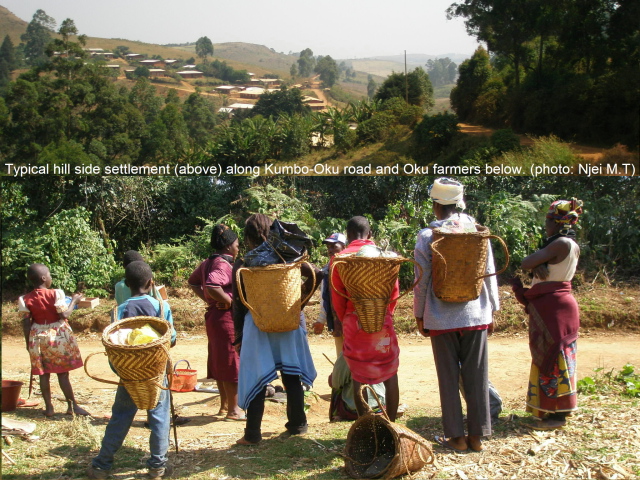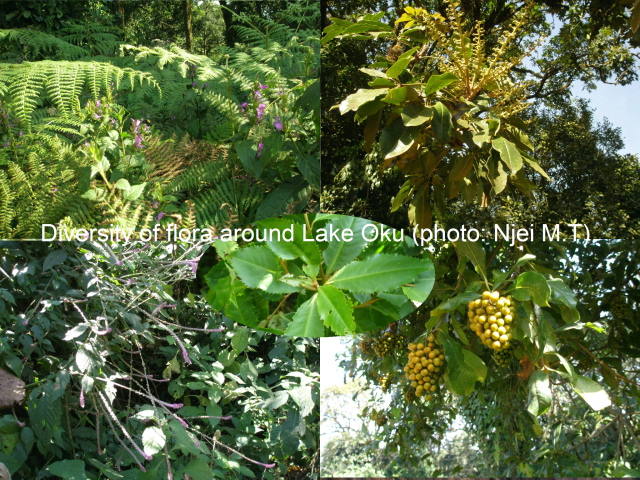15 Jan 2008
Oku is hilly region in Bui Division in the N.W province of Cameroon. Apart from its reputation of having some of the best sculptors in Cameroon, the people of N.West province believe that Oku people are leading herbalists and soothsayers. So when I and my sister Njei Grace mentioned that we were going to Oku, it raised more than casual attention.
Oku is not very far from the N.West provincial headquarters Bamenda (less than 120 kilometres), but it did take us about three and a half hours to drive from Bamenda to Oku via Kumbo due to the poor state of the road. Portions of the road that are not tarred were dusty and bumpy because it was dry season period otherwise it is usually slippery and bumpy in the rainy season.
The scenery along the way is very beautiful. (See rock image along the Bamenda-Kumbo road at this link http://www.njeitimah-outlook.com/albums/album_image/2075996/1180265.htm
There is first the steep climb from Bambui to Sabga and an equally steep descent into the Ndop plain that lies at the foot of Sabga hill. At the end of the Ndop plain is another meandering climb at the Wainama hill. Any view from the top of the hills along the way reveals breathtaking beauty of the Savannah vegetation of this region. Kumbo is the administrative headquarters of Bui division and it is a highly populated town. (See image of roadside traders near Kumbo http://www.njeitimah-outlook.com/albums/album_image/2075996/1590625.htm
From Kumbo, we headed for Oku. Our first stop was at Elak Oku where the paramount ruler or ‘Fon’ of the 34 chiefdoms of Oku resides. In addition to the 34 chiefdoms that share common ancestry, there are 2 ‘aldorates’ (special ‘chiefdoms’ headed by ‘Aldos’ or ‘Borroro chiefs’.

The Borroros (who are predominantly Muslims) are culturally different from the rest of the local communities in the North West province and they are principally engaged in pastoral farming –mostly rearing cattle on the large expanse of grassy hills. In the past they were leading nomadic lives but today many have settled and are being integrated albeit slowly into the rest of the community. (See image of Bororo women at this link http://www.njeitimah-outlook.com/albums/album_image/2075996/1180266.htm
In all, the 36 chiefdoms of Oku number about 120,000 people.
We arrived Elak Oku late in the Afternoon and we insisted to pay a courtesy call on the ‘Fon of Oku’. (read article on this link http://www.njeitimah-outlook.com/articles/article/2076041/94328.htm
Due to time constraints and the nature of the road, we had to push forward our visit to Lake Oku and the Kilum Forest reserve to the following day as we were told that it will take us over three hours to get there from Elak Oku and back. For the services of a tour guide and the right to take photos, we each paid the sum of 5,000cfa ($12) at the tourism office located within the palace complex. We took a double bed room at a guest house in Elak Oku for 5000cfa/night. The comfort was ok.
As our car could not dare the rugged road to Lake Oku, we decided the following morning to hire a four wheel drive Suzuki Jeep for 8000cfa to get there. In Oku, one is either climbing or descending. As you get along, you find sparkling water flowing from the hillsides. There seems to be abundance of drinkable water sources in this hilly area. At least six rivers or streams in the North West province can trace their source to the Oku Mountain range.
Lake Oku located on the Oku Mountain range is a crater lake that is completely surrounded by Montane Forest. (image of lake Oku http://www.njeitimah-outlook.com/albums/album_image/2075996/1593238.htm
The forest that forms part of the protected Kilum-Ijim Forest Reserve has a variety of exotic plant and animal species. A survey by Birdlife International in the mid eighties revealed a rapid rate of deforestation following the collapsed of coffee prices (a crop that sustained many peasants in that region). In 1987 the Kilum Moountain project began with the involvement of the communities in the sustainable management of the forest resources. In 1995 the neighboring Ijim Forest project was brought together to form the Kilum-Ijim Forest project. The Oku communities manage the Kilum part of the forest while the Ijim part is managed by communities in Kom. According to Mbuh Samuel, the Kilum Forest Management Officer, the total surface area of the combined forest is about 20,000 hectares and Kilum makes up 50% of that area.

The people of the area have come to realize that they stand to gain from sustainable forest management. The forest provides the villagers with firewood, wood for carving, building materials, income from ecotourism, meat and honey. The honey industry here is more advanced than in many parts of Cameroon. A unique brand of white honey consumed in Cameroon comes from Oku. The same can be said about the manufacture of wooden products. A variety of beautiful carvings are produced here. With regards to ecotourism, Oku is gradually picking up despite the poor state of the roads. Nature lovers will certainly gain from touring this area. According to a 2003 article by Birdlife International; “At least six of the 62 mammal species recorded in the forests of Mount Oku are found nowhere else”.
This piece will be incomplete without a word about the people of Oku. The people here are hardworking, at ease with strangers and generally friendly and respectful. Oku has produced prominent people that are household names in Cameroon like Prof Tatah Mentan, Fai Yengo Francis, Yang Philemon and the late Epssy Ngum and Francis Dom amongst others.
See image of Oku's disappearing architecture at this link
http://www.njeitimah-outlook.com/albums/album_image/2075996/1591496.htm
Njei Moses Timah
|